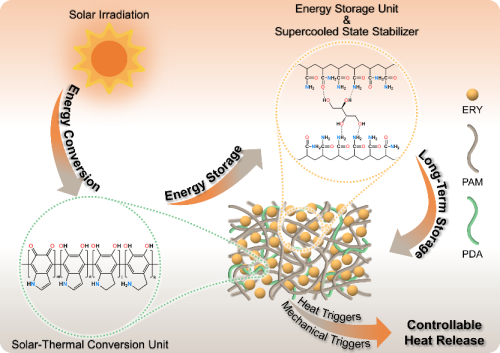Solar thermal fuels (STFs) can convert solar energy into chemical energy, which can be stored for a long time and released as thermal energy through specific triggers when needed.
STFs are promising for solar thermal utilization since they can address the problems of solar energy's intermittent availability and weather/geographic dependency. However, the current research on STFs mainly focuses on molecular-based materials with different molecular conformations showing energy differences, which pose challenges in practical large-scale applications.
Recently, a research group led by Prof. SHI Quan from the Dalian Institute of Chemical Physics (DICP) of the Chinese Academy of Sciences (CAS) has proposed an erythritol (ERY)-based spatiotemporal phase change material (STPCMs) that can serve as a new type of STFs, and have the potential for large-scale applications.
This study was published in Angewandte Chemie International Edition on Feb. 20.
The researchers demonstrated that the developed erythritol-polyacrylamide-polydopamine (ERY-PAM-PDA) composite STPCMs had the spatiotemporal utilization of thermal energy and photothermal conversion ability.

Schematic diagram of the composite STPCM (Image by ZHANG Shihui)
The researchers found that after introducing a photothermal conversion unit, the composite STPCM exhibited good photothermal conversion efficiency and realized the conversion and storage of solar energy into thermal energy. In addition, the composite STPCM could store thermal energy for more than a month at room temperature and then controllably release the stored latent heat via thermal induction or mechanical triggering. The cold crystallization enthalpy could reach 224.9 J/g, and the released latent heat could heat the system from room temperature (25 °C) to 91 °C.
The composite STPCM reported in this work is a promising alternative to molecular-based STFs. It exhibited spatiotemporal utilization capabilities for thermal energy and photothermal conversion ability in the visible light region. Moreover, it had simple preparation methods, used cheap and readily available raw materials, and was applicable to large-scale production.
"This work provides a new direction for the application of STPCMs and the development of solar thermal utilization technology," said Prof. SHI.
The above work was supported by the National Key Research and Development Program of China and the National Nature Science Foundation of China.